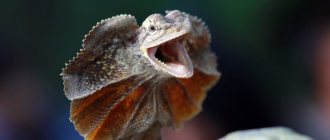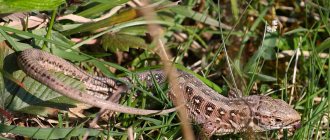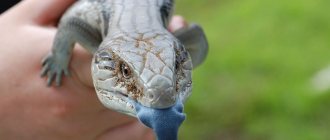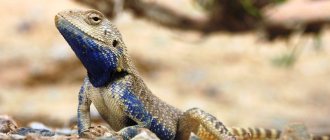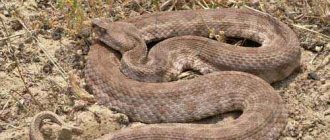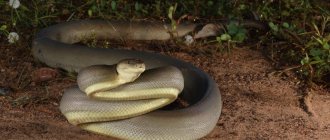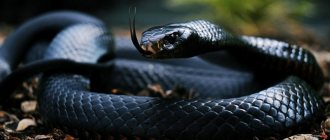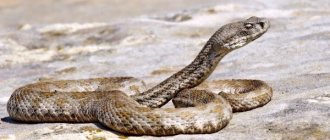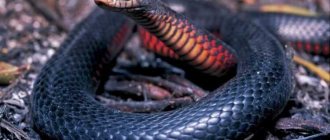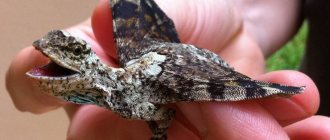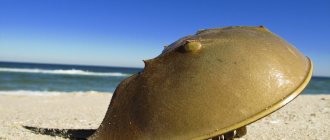If a snake looks at you and blinks, you know that it is not a snake, but a yellow-bellied lizard. This amazing animal does not have paws, which misleads the unenlightened person.
Where can you find this unusual reptile? The main habitats of the yellow-bellied lizard are Central and South-West Asia, Eastern Europe, China, West Africa, North America. These animals prefer to settle in different places. For some, steppes and semi-deserts are suitable, others choose river valleys, and still others choose mountains. In order to hide from predators and people, the yellow-bellied lizard independently digs holes or hides in those left by other animals, dives into bodies of water, and crawls under bushes and tree roots. In our country, this reptile, which is scientifically called the armored spindle, is often found in Anapa.
Appearance
The body of this reptile is serpentine - elongated from the sides and turns into a long tail. It grows up to 120-150 centimeters. If you look at its face separately from its body, you can clearly see that it is a lizard. Its head is large, with auditory openings visible on the sides. Adults are yellow, brown or copper in color. They differ from young ones in their darker shade and the absence of transverse zigzag stripes. Young lizards usually have 16-22 of them. As a reminder of its limbs, the yellow-bellied lizard has tubercles near its anus.
Lifestyle and behavior of the yellowbell in nature
This representative of the squamate order prefers open areas, so it can be found in semi-deserts, on mountain slopes, in the steppe, in vineyards and woodlands. The yellow belly also loves to live in fields. In mountainous areas it climbs to a height of 2300 meters above sea level.
A couple of yellowbellies living in a terrarium.
Active life activities take place during daylight hours. This animal does not really gravitate towards damp and hidden places from the sun; on the contrary, most often it crawls out into the sun and spends time basking in dry, open clearings. But if the day is too hot, the yellowbell may hide in a thicket of bushes or a pile of stones.
However, the yellowbell still requires water, but for this it uses shallow waters. Having climbed into the water, he can sit in it for a long time, despite the fact that he hardly knows how to swim.
The lack of flexibility of the body does not prevent this amphibian from crawling at an impressive speed. During the day, a yellow belly can crawl in different directions across an area with a radius of 200 meters.
Will not offend a person
Strong jaws are excellent at catching and eating prey. However, for some reason the yellow belly cannot protect itself from human touch with their help. Therefore, a person can safely pick up this harmless creature and take a closer look. She won't bite. But he can make it so that you yourself release her into freedom. This animal sprays its enemy with feces that have a pungent odor. So the hand will open involuntarily. Some believe that the yellow-bellied lizard is poisonous. This is wrong. It kills its prey in a completely different way.
What are the natural enemies of legless lizards?
Because of their unpretentiousness, yellowbellies have become favorite inhabitants of many home terrariums.
Sometimes these animals become prey for foxes, dogs, hedgehogs and some birds of prey.
Delicious dishes
First, let's figure out what serves as food for this reptile. It eats insects, invertebrate mollusks, and small vertebrates. If he manages to get it, he does not disdain bird eggs. In times of hunger, it eats fruits. Interestingly, when meeting with a viper, the yellow-bellied one will win. Its body is covered with hard scales, which prevents the snake from biting and injecting poison. And the jaws are so powerful that they allow the lizard to easily bite a viper in half. After this, the snake will be eaten. The yellow belly eats by biting off its prey one piece at a time, rather than swallowing it whole. Therefore, this process is long. The yellowtail can bite off the tail of its relatives, which it also eats.
How to distinguish a yellowbell from a snake
If, while walking through the secluded parks of Anapa, you suddenly come across a creature that looks like a snake, do not panic, maybe it is a harmless yellow-bellied lizard. The main signs by which you can distinguish our hero are eyes that have eyelids. Take a closer look, maybe an imaginary snake winks at you or blinks slowly, then this is a yellow-bellied snake. Also, snakes do not have a pronounced longitudinal fold or auditory openings on the sides of the head. The yellow belly will not be able to curl up into a ring; the strong parts of the shell will not allow it.
Sad but useful
As is known, in these representatives of the fauna the tail grows back. The same thing happens with the yellowbell. It can shed its tail, which it then grows back.
So, how does the yellow-bellied lizard, a photo of which you will find in this article, cope with small rodents? Very simple. She grabs, for example, a mouse, clamps it in her jaws and begins to spin in place until the rodent loses consciousness. And then he begins his meal. Quite a cruel way. But you can't argue with nature. Moreover, the yellowbell benefits agriculture by destroying snails, slugs and small rodents that spoil the crop. For the same purposes, you can bring it to your personal plot.
Contents in a terrarium
At home, such lizards are kept alone and united only during the mating season. For an adult reptile, you will need a horizontal terrarium; its parameters should be:
- length - from 100 cm;
- width - from 60 cm;
- height - 50 cm.
To create ideal conditions, it is necessary to lay river sand mixed with fine gravel at the bottom of the tank. In addition, a drinking bowl and a separate container with water are installed in the terrarium so that the reptile can swim in it if desired.
The yellowtail loves bright light and needs ultraviolet rays, so you will need to install special lamps. But you shouldn’t place them too close to the tank, otherwise your legless pet will get burns. Temperature is also important for your pet. During the daytime, the air should warm up to +30 °C, and at night it should drop to +20 °C. As for humidity, it is better to keep it at 60%. In addition, it is necessary to build special shelters in the terrarium. Suitable for this:
- small driftwood;
- clay and ceramic elements;
- medium sized stones;
- tree bark.
As for feeding, the diet of yellowbellies must include live food in the form of insects; you can feed them mice, snails, earthworms, and bird eggs. It is allowed to periodically feed pets with fruit and vegetable slices, mixing them with curd mass or boiled eggs.
In addition, you need to regularly add mineral supplements in the form of bone meal, you can also use calcium glycerophosphate, but it must be served with soft food.
At the end of autumn, it is necessary to create conditions for the yellowbelly in which it could hibernate. This can be done by gradually reducing the air temperature to +5 °C. It is also necessary to stop feeding your pet exactly two weeks before anabiosis.
The legless lizard brings many benefits. It destroys many small pests that harm agriculture by destroying crops. You shouldn’t be afraid of it: unlike the snake, the yellowbelly is non-venomous. He is a completely harmless reptile.
https://youtube.com/watch?v=BcesS0whSEw
New individuals
In nature, lizards live 30-35 years. Puberty occurs as early as 4 years, when the reptile is about half a meter long. After fertilization, the female lays eggs. Usually no more than 6-10 pieces in one litter. The eggs are oval in shape and size 2-4 centimeters in transverse diameter. For 30-60 days, the female guards her cubs and the nest hidden in the foliage. Warmth is what is important for the development of small lizards. It is best if the ambient temperature is about +30 degrees. As a result, cubs about 15 centimeters long are born. Yellowbellies can live in captivity. But they will reproduce only if the owner guesses the gender and puts a female and a male in the same terrarium. And it will be very difficult to guess.
Lifestyle
At the end of autumn, with the first cold weather, the legless yellow-bellied lizard hibernates until spring. During the warm season, it basks in the sun most of the day. And in the morning and at dusk he goes hunting.
Like many reptiles, the yellowbelly molts. But unlike snakes, which shed their skin in the form of a stocking, Pseudopus apodus does this in pieces.
Like other species of lizards, it can throw off its tail in times of danger. It is separated reflexively as a result of muscle contraction with a smooth fracture surface. The new tail grows shorter and crooked.
In nature it feeds on mollusks and insects. In some cases, it can eat a small vertebrate animal, chewing it instead of swallowing it whole, like a snake. When eating large prey, the folds on the body are smoothed out. It also includes ripe juicy fruits and bird eggs in its diet.
Pets
But usually reptiles are kept not for the sake of reproduction, but to observe their life. Owners especially enjoy the feeding process. After all, you can give food to a yellow belly by hand. But do not forget that an untamed lizard will be afraid of you and throw liquid, odorous excrement at you. It will take some time for your pet to get used to it.
Prepare a flat, horizontal terrarium, the bottom of which is covered with sand interspersed with coarse gravel. Make shelters. After all, the yellow belly in nature hides from the heat and rain. It is necessary to install a lamp to maintain the optimal temperature. The terrarium should have a feeder and a drinker. In captivity, lizards eat the same things as in nature: insects, rodents, eggs and fruits. You can also give small pieces of meat or chicken. The main thing is to monitor your pet’s health and not give him anything that will make him feel bad.
Our nature is full of miracles. The legless yellow-bellied lizard, interesting facts about which you found in this article, is one of them. We wish you to meet it in nature to see for yourself what an interesting creature it is.
Habitats
Yellowbellies have an extremely limited geographic distribution. They can be found in South-West and Central Asia. In addition, they are localized in Europe, but only in its eastern part. Depending on their habitat, they are divided into the western species (these yellowbellies are much longer and larger than their relatives from the East) and the eastern one, whose representatives look normal.
These reptiles can live in different places. Some choose steppes and semi-deserts as their homes, others prefer to settle on high mountains and river valleys, and still others even dig minks in fertile lands where rice, grapes or cotton are grown. By the way, the yellow belly can easily exist in water - in it it often hides from all kinds of enemies.
The yellowtail can exist both in water and on land.
California lizard
The California legless lizard is not very large. Its worm-like body reaches a length of only 25 centimeters, and this is the maximum. The upper part of the body is colored grayish-olive or brownish. Some subspecies are dark brown or even black in color. The underside is usually yellow and the head is dark. In young individuals, three longitudinal lines on the body are clearly visible.
This reptile is common on the California coast. For this, the lizard got its name. You can also meet her in San Francisco. It makes passages in the ground at a depth of 10-15 centimeters. It settles most often in areas with sparse vegetation and sandy soil. However, this does not mean that it cannot be found in the rocks. Tree trunks lying on the ground, voids under stones - the lizard uses all these places as shelters.
The food for the California lizard is soil insects, their larvae, spiders and various arthropods. She mines them underground. The reptile also hunts on the surface of the soil, detecting the location of prey by smell and quickly grabbing it with its head sticking out of the sand.
Spindle
The legless spindle lizard has a beautiful appearance. Its scales are very smooth and shiny. It is painted brown, brown or dark gray with a bronze tint. Males have small blue spots on their backs. In captivity, reptiles molt in about a month.
The legless lizard (spindle) feeds on mollusks, earthworms and insect larvae. It holds prey with sharp teeth bent back. Thanks to this, slippery worms and slugs remain in the reptile's mouth. The lizard absorbs food in the following way: it swallows slowly, moving its head in different directions. If the worm grabs onto something and does not leave the earthen hole, then the spindle straightens its body and begins to rotate in one direction. In this way, she tears off part of the prey. When eating snails, the reptile slowly pulls the mollusk out of its shelter, first resting its head against the mouth of the shell.
Reproduction
The mating period begins after emerging from winter anabiosis - from March to May. Only specialists, by studying behavior, hormonal levels and other implicit characteristics, can determine whether an individual is a female or a male.
At the beginning of summer, the yellow-bellied lizard lays from six to twelve oval-shaped eggs, which have approximately two centimeters in transverse diameter and four centimeters in longitudinal diameter.
The reptile buries the clutch in the leaves and guards it for thirty to sixty-five days, turning the eggs over and cleaning them from dirt. Comfortable temperature for embryo development is 30⁰C.
The young are born up to twelve centimeters long, excluding the tail.
The yellowtail reaches sexual maturity at four years. At this point, the size of the body increases three times from birth. The total lifespan can be thirty years.
Security
As an endangered species, the yellowbell is listed in the Red Book of Ukraine and the Red Book of Kazakhstan. It is listed as endangered in the Red Book of the Krasnodar Territory. It is protected in the Aksu-Zhabagly Nature Reserve, in the Yalta Mountain Forest, Cape Martyan, Crimean and Kazantip nature reserves. Measures to preserve the species include relocating lizards from declining urban populations to nearby protected areas, strengthening the protection of the Karalar steppe, reintroducing the species into the Karadag and Opuk nature reserves, and outreach to the population.
It was the yellowbellies that portrayed snakes (of which the main character Indiana Jones is terrified) in Steven Spielberg's film Raiders of the Lost Ark. It is curious that the English name for lizards - sheltopusiks - is a slightly distorted version of the Russian word.
a brief description of
The legless lizards that will be discussed in this article look like snakes. They are missing limbs. Their eyelids are movable. These reptiles lead an underground lifestyle: they spend most of their time in the ground. With the help of a shovel-like head, as well as thanks to specific body movements, they make numerous passages in loose soil. Legless lizards feed on insects and invertebrate organisms.
These reptiles are ovoviviparous. At one time, a female can bring several cubs, most often no more than four. Lizards reach sexual maturity at three years.
Who are legless lizards and why are they legless?
At some point in evolutionary development, some of the ancestors of lizards decided to go “underground.” Apparently, there were too many enemies on the surface, and they began to master the underground and litter life. They did not follow the path of moles, who made their legs into digging tools; it seems that worm-based methods suited them better.
By the way, there is a whole family of worm-like lizards (Dibamidae) that live mainly in the upper loose layer of forest litter in southern India, China, Indonesia and Mexico. Externally, oshes are almost no different from earthworms. But they have teeth and a tail, which they can throw away.
Let's go back to the legs. Legless lizards do not have no legs at all; some rudiments (or rudiments), as well as shoulder and pelvic girdles, are present. It seems that they have not decided whether they need legs or not, and just in case they left the possibility of restoring them. Different types - to varying degrees.
In vermiforms, practically nothing is visible or palpable from the outside, not even the anterior shoulder girdle. But snake lizards (Ophiomorus), living in central and southern Asia, Australia, and the Balkans, have legs, but they are completely “frivolous.”
The common lepidopus (Pygopus lepidopodus), living in Australia and the surrounding area, also has nonfunctional hind legs They do not operate with rear-wheel drive, but by their legs you can determine where its tail begins, which occupies almost 2/3 of the entire length of the reptile. Unfortunately, such an exceptional tail is quite brittle and does not reach its original dimensions when it grows back.
There are generally many exotic creatures in Australia. Among the lepidopods living there, there is an interesting species - Barton's lialis (Lialis burtonis), which attacks its potential food with a throw from cover and holds it by the neck with its teeth until the victim gives up the ghost. In case of danger, they themselves squeal piercingly, frightening their enemies. The tails can also be discarded if necessary.
More about tails: the American glass lizard (Ophisaurus attenuatus) can drop its tail even if it is not touched, but simply frightened. Moreover, the tail can disintegrate into several parts (hence the name - glass). While the attacker looks at the wreckage in a daze, the lizard manages to escape. The new tail does not grow back to the same length and is different in color.
All legless lizards have mastered mainly the subsurface and litter layers, but they have not abandoned life on the surface either: it is easier to hunt on the surface, but to hide under it. Only worm-like and American legless (such a family) decided to finally go into the ground, some even had vision atrophy.
Of all the rather large variety of lizards whose legs have withered due to uselessness, only two live in Russia: the brittle spindle (Anguis fragilis) and the yellow-bellied lizard (Pseudopus apodus).
Glass lizard (Ophisaurus attenuatus). © JD Willson
Common scalepod (Pygopus lepidopodus). © Ian Bool
Barton's Lialis (Lialis burtonis). © Chris Wiley
